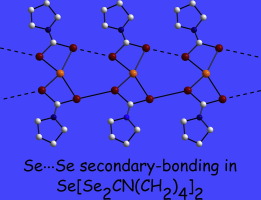Molecular and supramolecular chemistry of mono- and di-selenium analogues of metal dithiocarbamates
See Mun Lee, Peter J. Heard, Edward R.T. Tiekink
Index: 10.1016/j.ccr.2018.03.001
Full Text: HTML
Abstract

This bibliographic review summarises the coordination chemistry of mono- and di-selenium analogues of metal dithiocarbamate ligands, [RR′NCS2]−, as revealed by X-ray crystallography and spectroscopy (77Se NMR and infrared). The Se-ligands are usually chelating but, bridging modes, up to μ4, are known. Reflecting the larger size, greater polarisability and presence of a polar-cap (σ-hole), selenium atoms are more likely to be involved in secondary-bonding (chalcogen-bonding) than sulphur when a competition exists. Isostructural relationships are established across the series in about one-third of the structures.
|
Tridentate pyridine–pyrrolide chelate ligands: An under-appr...
2018-03-28 [10.1016/j.ccr.2018.01.012] |
|
Recent advances about metal–organic frameworks in the remova...
2018-03-19 [10.1016/j.ccr.2018.03.015] |
|
Recent advances in ultraviolet and deep-ultraviolet second-o...
2018-03-15 [10.1016/j.ccr.2018.02.017] |
|
Luminescent oligonuclear metal complexes and the use in orga...
2018-03-13 [10.1016/j.ccr.2018.01.017] |
|
Biological applications of Ru(II) polypyridyl complexes
2018-03-09 [10.1016/j.ccr.2018.02.013] |